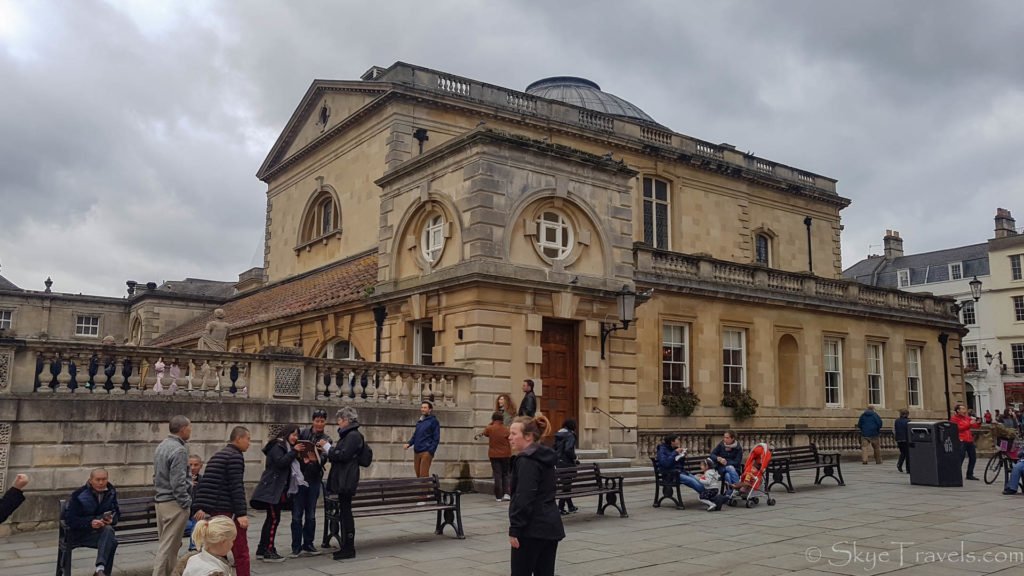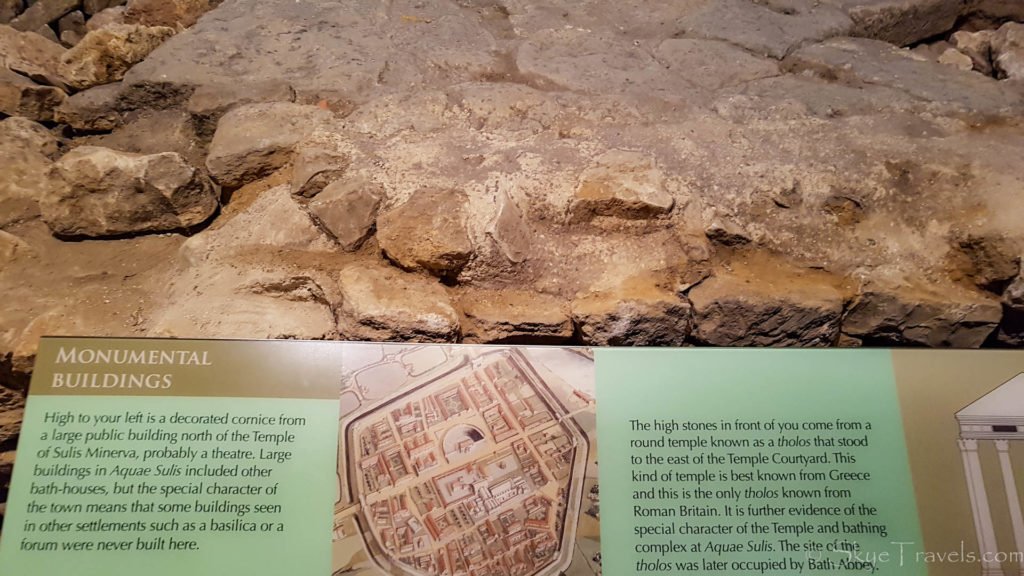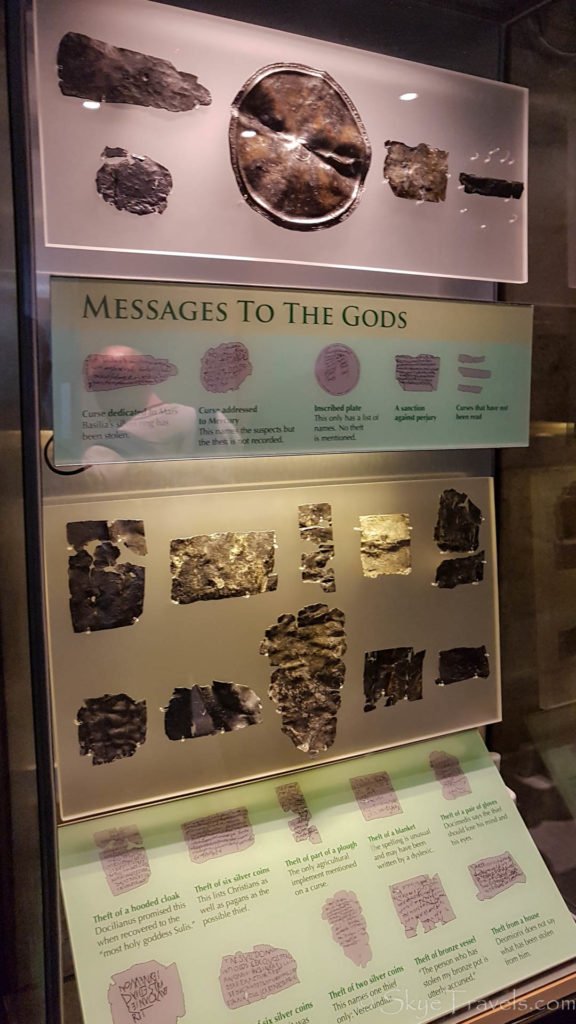The first time I saw the Roman Baths in the town of Bath, England, I only viewed what I now know is the King Bath, a small pool where the thermal springs first emerge from the ground. It wasn’t until my third visit to Bath when I finally explored the rest of the complex, and boy is it extensive. Two hours to explore all the rooms, and I still didn’t get a chance to read all the information displays or even take the free guided tour.
Where Are the Roman Baths?
Bath, England is a small town of 85,000 people, a mere 15-minute train ride east of Bristol, 90 minutes by train from London, and an easy excursion from the Cotswolds. The Roman Baths are located in the center of town. They span dozens of rooms in addition to a large underground exhibit. The original Roman town of Aquae Sulis, meaning the waters of the deity Sulis, goes back to 863 BC. The Roman settlement was eventually buried under several meters of silt from nearby River Avon. While the baths have been used by the English for centuries, the excavations didn’t open as an attraction until 1897.
A Visual Tour of the Roman Baths
The tour begins with walking around the upper terrace of the main bath. Bath Abbey rises up in the background just a few feet away. Statues of Roman emperors line the terrace, looking down into the pool.
A large, two-level information center has been built over the original ruins, providing hundreds of artifacts, information displays and videos detailing the life of the Romans at the baths. A massive collection of Roman coins found near the baths in 2012 are on display.
One of the more interesting displays is the curses – messages to the goddess Minerva (Sulis) that were etched into metal and thrown into the baths. Many of them request punishment on people who stole possessions such as sandals and robes worn to the baths. It appears theft has been a major problem in our society for millennia.
After the souvenir shop, you’ll come to the ground floor of the main bath. Free guided tours happen every hour on the hour to show you around and give you more information on the baths.
Next to the main bath are several more rooms. Some contain smaller baths, while others were used as saunas and changing rooms. In the 2nd century, a Roman mandate decreed that men and women would bathe separately, and new pools were built. The women had three pools – the caldarium (hot bath), tepidarium (lukewarm bath), and frigidarium (cold bath). On the men’s side, you can throw coins into the pool to support the renovations and opening of another large group of rooms recently discovered.
At the end of the tour, make sure to visit the fountain where you can drink water directly from the springs. It contains over 42 minerals, more than twice as much as San Pellegrino sparkling water. A new well was bored in 1983 to provide clean water for the fountain as well as the nearby spa.
Visiting the Roman Baths
The Roman Baths are available to visit 9:30 a.m. to 5:30 p.m., with longer opening hours in the summer. Ticket prices are £15.50 for adults and £9.80 for children during the winter season. 2018 prices have yet to be posted. Make sure to bring comfortable shoes, preferably some boots which won’t slip as the stones around the pools can be slick. Book your visit here.
Bathing in the Roman Baths
While you can’t enter the waters at the Roman Baths themselves, the mineral-rich water is pumped to the Thermae Bath Spa next door. Three pools are available to swim in, as well as several other facilities including saunas, massages and relaxing showers. Read more about the Thermae Bath Spa here.
Other Activities to Do in Bath
The Roman Baths aren’t the only attractions in Bath, itself one of the best places to visit in the south of England. Jane Austen lived in Bath from 1801 to 1806. You can visit the Jane Austen Center, or take one of the Jane Austen walking tours. See the rest of the attractions from a free walking tour or the Hop-On, Hop-Off Bus Tour, and be sure to visit in December to see the beautiful Bath Christmas Market.
Click to Pin It
Planning to Visit England?
Here’s some extra reading to save hundreds on your next vacation or stage of your journey.
- 5 Steps to Book Cheap Flights
- Hostels: To Book or Not to Book
- Is Workaway Worth it for the Traveler?
My deepest thanks to Visit Bath and the Roman Baths for inviting me to experience the Roman Baths. As always, my views and opinions are entirely my own.
This post may contain affiliate links. These links help give me the wherewithal to continue traveling at no additional cost to you. For more information, click here.
























22 Comments
I have to admit that I do not know much about Bath. Of course, I heard about it. Come to think about it, perhaps mostly from some British novels where main personages went there for a weekend or a vacation. Judging by its name, I assumed that baths of some sort played an important role in the past. However, I was surprised to read about Roman baths. Forgive my ignorance, but Britain is not the first thing that comes to my mind thinking about Romans. I wonder how good citizens of Aquae Sulis liked their weather? Was it different back then? I guess the caldarium was used more than frigidarium. Funny how humans appear to be stuck in their ways. Petty theft seemed to be a “popular” pastime if people resorted to asking Minerva for help. Thank you for sharing your experience and history of the Roman Baths. Even though I am not going to Bath anytime soon, I enjoyed learning something new.
You’re very welcome. England does have some really interesting Roman history, and Bath is a great place to learn about it. I think their weather was similar, although perhaps not since I believe there were more forests around then. If I remember correctly, the baths were used in sequence, with people going into the cold, luke-warm and hot baths in that order. I’m sorry to hear you don’t have plans to visit in person. Hope you do get there someday.
I loved exploring the Roman Baths – Bath is my favorite UK town, we did a day trip from London last year and next time I’ll be booking to stay for a couple of days. You’re right – the baths themselves are extensive! You could easily spend a full day!
I didn’t actually visit the spa though, so would love to take the opportunity to bath there on my next trip.
Bath really is my favorite UK town too! I still want to go back for my third trip to the spa. I hope you can make it there soon too.
Looks like quite a lot of history in Bath, England! The complex looks quite massive. I like that so many people were fixated on asking the gods to curse whomever had stolen their sandals or robes at the baths – seems like the same antics have been going on for hundreds of years. With the cold weather coming on a dip in the Thermae Bath next door sounds pretty nice.
Yeah, I really learned a lot more about the Roman culture from this city! I certainly hope you can make it to the spa!
What a fantastic “tour” of the spas and Roman history and culture. Winter is coming and as I read your article and look out the window, all I want to do is jump into the hot bath. Now I know how the town of Bath got it’s name. Looking forward to making it to Bath soon!
It was freezing my first trip to the Bath Spa, and sitting in the rooftop pool was absolute heaven. I guess it would be safe to say the English called it Bath because of the Romans bathing there, since the Roman’s were calling it Aquae Sulis. Definitely worth a visit!
Wow, those Roman really enjoyed their baths, don’t they? They look huge! And I can’t believe curses were etched in coins. I would love to see that coin collection. I wonder if it curbed the thefts at that time? Bath seems like a very lovely place to visit, esp those who are fans of Jane Austen as well.
The curses and the coins weren’t connected, except that they were both thrown into the water. I think Bath might be one of the most charming towns in England. I haven’t been to them all, but it’s my favorite so far.
If you have an interest in bath houses like this, I recommend watching the movie called Terumae Romae (it’s in Japanese, but you can find version with subtitles). The movie is about an ancient Roman who builds bath houses. After accidentally time traveling to modern day, he returns to Ancient Rome and uses what he saw here as inspiration for the bath houses he built in Rome.
As for this bath house, it looks like a great experience! Bath houses aren’t exactly something that make the history books, so being able to go through and see all the artifacts would be really interesting. The bath spa would also be cool to give you that “almost” experience of the ancient bath houses.
That sounds like a really cool movie. I’ll definitely have to check it out. Yeah, the Bath Spa uses the same water, and with the recent renovations to the Wellness Suite, it does actually feel like you’re sitting in a real Roman steam room. Hope you can make it there someday.
Wow! This is amazing! I had no idea there was so much to see in Bath! We’re heading here in May and now I’m even more excited to visit! I love that the information center has so many amazing artifacts. I love that kind of stuff!
Hope you have a great time there. Do make sure to spend an evening at the Bath Spa. Plan to spend at least three days to see all the highlights in the city.
I’ve got Bath on my list for the next time I’m in the U.K. The history of the hot springs and the recovered Roman artifacts would be great to tour through and see. You’ve piqued my interest in reading more about Aquae Sulis. Incredible to think it was just covered over by the River Avon! I’d also have to do one of the Jane Austen walking tours. I never realized she lived in Bath. 🙂
Thanks! She was only here for five years, but the city has definitely built it’s tourism around her, as well as the Roman Baths. Did you know there are several River Avons in the UK? Avon actually means river in Gaelic, and they would just call the river as a river, so the clever English settlers ended up calling numerous rivers the River Avon, which just means the River River. LOL
I visited Bath a few years ago and absolutely loved the Roman Baths and the Georgian architecture in town. Did you spend any time at the spa?
I did! It was my second visit there. Skyetravels.com/Wellness-Suite. Such a beautiful town. I kinda feel I’ve seen it all now, but I still would go back just for the beauty.
Would so loveeee to take a soak in the Thermae Bath Spa! It seems like the tours of the roman baths were very interesting! I’m amazed that they didn’t find the coins until recently and it’s pretty cool that it’s the largest roman coin hoard. Also would love to taste the water with its 42+ minerals!
Thanks. Don’t forget to read my post on the Thermae Bath Spa as well. There were actually a bunch of coins found earlier in the pools, but the big hoard was more recent.
I love history and write about our family travels around our home state Ohio and beyond. I’m pinning this to one of my travel or history boards. Thanks for sharing!
Thanks! Hope you can make it there someday.